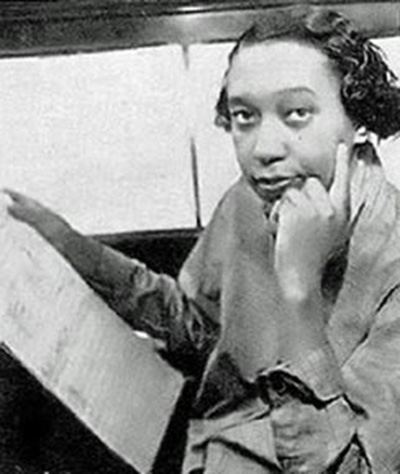Julia Perry

- Born: March 25, 1924, Lexington, Kentucky
- Died: April 24, 1979, Akron, Ohio
Homunculus C.F. for percussion ensemble, with harp and piano
- Composed: 1960
- Premiere: January 28, 1965, for a recording by the Manhattan Percussion Ensemble, Paul Price conducting
- Instrumentation: timpani, bass drum, crash cymbals, snare drum, suspended cymbals, vibraphone, wood blocks, xylophone, harp, celeste, piano
- CSO notable performances: First Performance: November 2020 at a livestream-only concert, Louis Langrée conducting.
- Duration: approx. 6 minutes
Within the changing dynamics of the Post-World War II concert hall, composer/conductor Julia Perry emerged as one of a number of black women composers whose music would point to new forms of experimentation. Unlike her peers Margaret Bonds, Undine Smith Moore, Hale Smith and George Walker, Julia Perry remains much of an enigma. But her musical activity and rich, diverse catalog frames a different perspective of how black composers and musicians navigated the politics of the Post-World War II concert scene.
Julia Perry was born in Lexington, Kentucky in 1924, but spent most of her formative years in Akron, Ohio. Her studies of violin, piano and voice prepared her for enrollment at Westminster Choir College after graduating high school. Perry expanded her musical studies to also include conducting and composition while at Westminster. She graduated with a bachelor’s degree in 1947 and a master’s in 1948.
Soon thereafter, Perry moved to New York, where she studied composition at Juilliard. The 1950s marked a period in which Perry’s development as a composer and conductor progressed significantly. In 1951, she began what would prove to be a long and rewarding musical relationship with composer Luigi Dallapiccola. She studied with the composer first at the Berkshire Music Center at Tanglewood, but the financial support of a Guggenheim Fellowship led to her continuing this work in Florence a year later. It was also during this period that she studied with famed composer/conductor/pedagogue Nadia Boulanger in France.
Perry spent much of the decade following World War II in Europe, studying, concertizing and conducting. Like many black musicians, she participated in concert tours and lectures sponsored by the United States Information Agency. Perry’s compositional voice soon displayed her mastery of modernist styles such as minimalism, atonality and serialism, along with the neo-Romantic aesthetic that flourished among black composers during the height of the Harlem Renaissance.
Perry’s work during the 1960s included short-term teaching stints at Florida A&M University and Atlanta University, and the cultivation of a private studio offering piano instruction. She composed prolifically, producing a catalog that stretched across genres. Her oeuvre came to include symphonies, opera, chamber music, choral anthems, arrangements of spirituals, and art songs. Despite the prolific nature of her work, only a few of Perry’s compositions were recorded during her lifetime. One was the well-known chamber work Homunculus C.F.
The work was written during the summer of 1960, when Perry was living in an apartment that was located above her father’s medical practice in Akron. The clinical environment of the office drew Perry to the Faustian legend—more specifically Wagner, the central character’s apprentice, and his experiments that resulted in the creation of a small man, Homunculus. It is the organic nature of alchemy—combination, transformation, creation—that underscores the structure and form of Perry’s composition.
Homunculus C.F. is written for percussion instruments, harp, xylophone, vibraphone, celesta and piano. Although the piece is fairly short, its form is realized through four sections that center on the introduction of base elements—rhythm, melody, harmony—that are then combined and varied in a systematic way, which can be viewed as a replication of the alchemical process that resulted in the creation of Homunculus. Melodic and harmonic elements are grounded in what Perry called the Chord of the Fifteenth (C.F.), the superimposition of two major seventh chords (E G# B D# F# A# C# E#). In the liner notes to the 1969 recording Perry wrote, “having selected percussion instruments for my formulae, then maneuvering and distilling them by means of the Chord of the Fifteenth, this musical test tube baby was brought to life.”
The work begins with rhythmic interplay between the non-pitched instruments (woodblocks, snare and bass drum, and cymbals). This exchange is amplified with the entrance of the timpani in what proves to be a transitional moment, introducing both melodic and harmonic elements that are varied in the next three sections. The second section is marked by the timpani establishing the foundational pitch of the C.F. (E-natural) as it engages with the harp.
The interplay between harp and timpani is soon interrupted by the entrance of the vibraphone and celesta, which introduces a new motive, further underscoring the harmonic aspects of the work. Having now established the elemental aspects of the work, Perry uses the last section of the work to bring them all together, culminating in the full articulation of her musical alchemy—her creation, the Chord of the Fifteenth.
In 1964, Perry received a grant from the National Institute of Arts and Letters, which financed a recording with the label Composers Recordings, Inc. (CRI). A year later, Homunculus C.F. was performed at the Manhattan School of Music. It worth noting that it is one of two works in Julia Perry’s catalog that references the Faust legend. The other is a play called Fisty M-E!
Despite the many health challenges that significantly affected her professional work during the 1970s, Perry continued to compose. She died on April 24, 1979, in Akron at age 55. Unfortunately, much of Perry’s personal writings and manuscripts were lost during the years that followed her death. These circumstances have contributed to her music falling into relative obscurity. However, renewed interest in the life and music of Julia Perry will hopefully not only rectify this, but also illuminate the true depth and diversity of her artistry.
—Dr. Tammy Kernodle